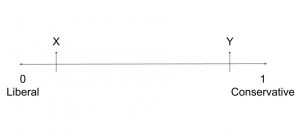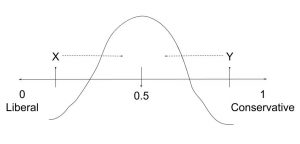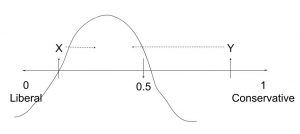Though we are still more than a year out from the 2020 presidential election, candidates are beginning to kick their campaigns into high gear and political tensions are ever rising. There are constantly headlines surrounding who has entered the race, who has dropped out, and articles that seem to make predictions about where the peoples’ votes will go and how candidates will run their campaigns. One of the biggest questions that voters will get the chance to answer is how the left is going to fare, given more extreme candidates, such as Bernie Sanders, have entered the running.
One way to make predictions about elections and how candidates may adjust their platforms to capture the most votes is by using the median voter model. Though this model is not intended to capture the nuance of candidacy in primaries and functions in a primarily hypothetical realm, it can give some insight as to why candidates tend to be more moderate than extremely left or right. Here’s how we are going to set the model up:
First, we will say that candidates range in their ideologies on a spectrum from left (liberal) to right (conservative), on a scale from 0 to 1. Each candidate can choose any position they wish, between 0 and 1, along this spectrum. Let’s say we have candidate X and candidate Y who are located at arbitrary points along the spectrum. 
Logically speaking, for each candidate to get the most votes possible, they are going to try to align their platforms more closely with the ideology that the voters collectively have. In this model, the location of the median of all voters is the Nash Equilibrium- where the candidates will want to locate to best respond to their opponent and simultaneously receive the most votes possible. If the distribution is even across the spectrum, the median voters will fall at a value of 0.5 and candidate X and candidate Y will split the vote evenly.
Thus, each candidate will shift their platform towards the center of the spectrum of political ideologies, and become more moderate to appeal to the median voters who also tend to be more moderate. If, however, the distribution of voters shifts so that they become more liberal overall, then it is likely that candidate Y may reposition to become slightly more moderate in order to appeal to more voters:
Though this model only covers a scenario for two candidates, it helps us think about a few important questions related to the 2020 presidential elections: How will the deep field from the left alter their platforms to capture the most votes possible? Have the median voters shifted left, and if so, will this accomodate more extreme viewpoints?
And, this model helps us think of questions about elections more generally: To what extent do candidates alter their platforms just to capture more votes? Are campaign platforms carefully curated to win, or do they actually try to represent the views of the candidate? How has the political ideology of eligible voters changed over time?
Though this model cannot give a specific prediction of the outcome of the 2020 election, it would seem that the median voter model provides an interesting way of examining political candidates and their campaign platforms. Perhaps, when the field is narrowed down to fewer candidates, this model would be more applicable, but in the meantime it helps us to see the way that candidates can treat elections like a game and try to outmaneuver one another.

This recent article about Inslee’s campaign has an interesting two-dimensional perspective on platforms, with ratings on a social score and an economic score. https://fivethirtyeight.com/features/how-jay-inslee-could-win-the-2020-democratic-nomination/